When creating your own software, a big decision is choosing the right technologies and tools. No tech stack is perfect, so you need to find the right balance between development speed, cost, and performance.
This guide gives an overview of Python and its tools, talks about the benefits and disadvantages of software development with Python, and shares examples of successful business applications.
Before we start, let us say a few words about Syndicode. We’re a custom software development company that helps businesses make software products from scratch. We do everything from shaping ideas and market research to picking the right tech and planning development. We work with all popular technologies, including Python, and always keep learning.
To show what we can do, check out this job search and HR platform that uses Python for machine-learning features (Fuzu).
Now, let’s dive into the ‘whats’ and ‘whys’ of Python in software development.
What is Python programming language?
A textbook would define Python as an interpreted, high-level, dynamically semantic, object-oriented programming language. Let’s break down what these properties mean from a business perspective.
- Python is an interpreted language, allowing a developer to skip the compilation step. This facilitates real-time testing and exploration of code snippets, significantly reducing the time necessary for software development using Python;
- Python is a high-level and dynamically semantic language. It eliminates strict type requirements and comes with built-in libraries and frameworks. Developers can focus on problem-solving rather than dealing with type declarations or complex hardware-specific intricacies;
- Python is an object-oriented programming language, enabling the seamless addition of new functionality to existing code without unintended consequences.
Moreover, Python adopts English grammar and emphasizes readability. This approach ensures that its code is easy to understand, write, and maintain. This characteristic simplifies the onboarding of new developers, requiring less time for them to adapt to the software.
Finally, Python is highly versatile and can be used for everything from simple web projects, like websites, to intricate tasks such as artificial intelligence and machine learning. So, if you were wondering if Python could be used for your software development project, the answer is likely yes.
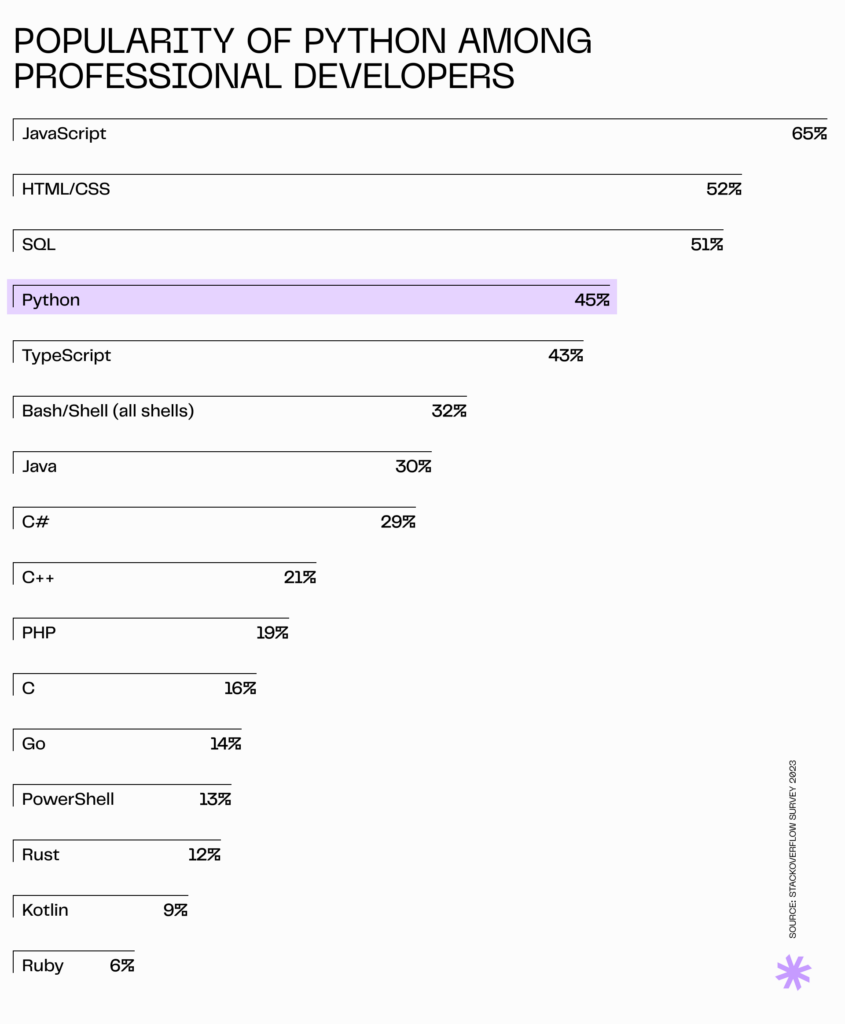
When to choose Python for software development?
As mentioned earlier, Python is a versatile programming language. It finds favor with numerous successful companies, including Meta, Spotify, Etsy, and Uber, which have integrated it into their products.
Now, let’s see when Python proves particularly advantageous for software development:
Rapid prototyping
Python’s syntax and interpreted nature lets developers work quickly and see results instantly. There’s no need to build code from scratch since many libraries and frameworks are available. These factors together greatly cut down the time needed for development, which is crucial when creating prototypes.
Cross-platform development
Python works on any platform as long as you have the right interpreter installed. The interpreter can be easily downloaded from the official Python website. Moreover, Python takes care of many operating system-specific details, so developers can focus on writing code without worrying too much about system differences.
Another helpful feature is Python’s virtual environments. These allow developers to work together on the same project, no matter what type of computer or operating system they’re using.
Scalability
Python is well-suited for a microservices architecture, making it a good choice when scalability is crucial. In this setup, large applications are constructed as a collection of smaller, independent services. This makes it easier to maintain each component separately. Additionally, this structure enables the scaling of individual services independently, without concerns about dependencies.
Handling complexity
Python provides interfaces with other languages, letting you select the most suitable technology stack for various services within your project. For instance, your application can be primarily written in Python, but you can integrate a feature that requires intense number-crunching by using C++. These components will work together seamlessly, sharing data without any issues.
Hiring constraints
Python is known for being relatively easy to learn, making it popular among developers. Moreover, its versatility allows it to be used for a wide range of software applications. The language also benefits from a large and active community, offering plenty of learning, troubleshooting, and networking resources.
All in all, these factors make Python an excellent choice for businesses facing limitations in local talent. You can easily find engineers skilled in Python software development, and training them according to your specific needs will likely be a straightforward process.
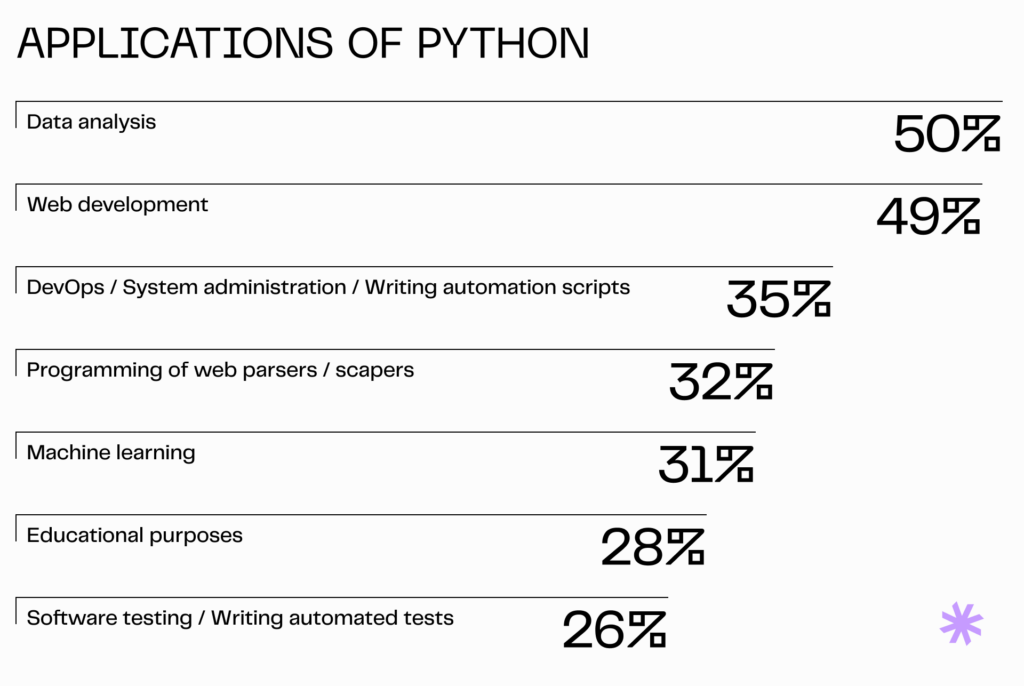
Searching for Python developers?
Your search ends here! Syndicode provides teams and individual developers with proficiency in Python software development, whether building from scratch or enhancing existing software. Explore our dedicated page for more details.
See servicesBenefits of using Python for web development
Creating software with Python is simple, thanks to the rich library and a thriving community that contributes to the language’s continuous growth. It’s open-source, works across various platforms seamlessly, and is widely embraced by developers.
But how do these features benefit you as a project owner? Let’s see.
Faster development cycles
Python’s syntax and a wide range of built-in tools reduce the amount of code required to express concepts. This accelerates the development process, allowing businesses to bring products and features to market more quickly. Besides, rapid development not only cuts costs but also enables early identification and resolution of issues, facilitating risk management.
Versatility
Python can be applied across diverse domains, allowing businesses to address different aspects of their operations using the same language. This versatility reduces the necessity to hire additional specialists for different aspects of the project, resulting in cost savings. Python also allows for project adjustments as requirements evolve without the need for a complete overhaul.
User-friendly interface
Known for its readability, intuitiveness, dynamic typing, and Interactive Shell, Python is recognized for its user-friendly programming interface. This characteristic simplifies the learning curve for developers, reducing onboarding time and resources. Additionally, it facilitates faster development cycles as developers spend less time deciphering complex code structures, debugging, and dealing with syntax intricacies.
Stability and reliability
As a mature and well-established language, Python has undergone continuous development, refinement, and improvement. With a large and active developer community, issues are promptly identified, reported, and addressed. Moreover, Python follows a rigorous testing process for new releases, supported by well-maintained documentation. This ensures that software built with Python is less prone to bugs and errors, making code updates and maintenance easier for long-term projects.
Security
Python incorporates built-in security features and receives regular updates and patches to address vulnerabilities. Its open-source nature encourages collaboration and transparency, allowing developers to collectively identify and address security issues. As a result, businesses that leverage Python for software development can have confidence in protecting sensitive data from unauthorized access, modification, or theft.
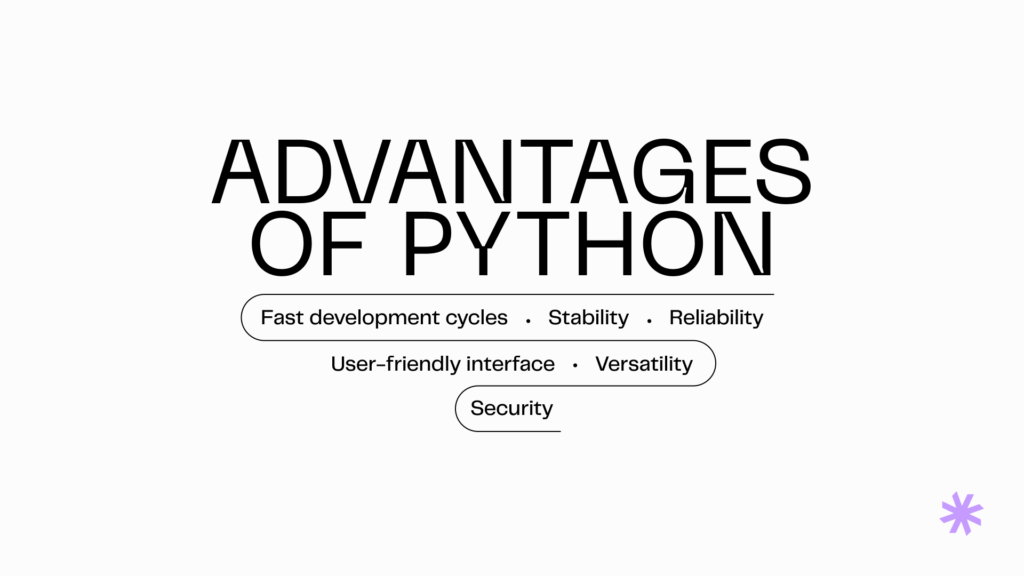
Popular Python frameworks and tools
Software development with Python benefits from a rich ecosystem of frameworks and tools that cater to various domains. The abundance of choices can be attributed to the open-source nature of Python, enabling developers to create and share their solutions.
When selecting a framework, it’s crucial to weigh your project’s specific requirements and the size and activity of the community supporting the framework. Let’s explore some of the most popular Python frameworks as listed on G2, and classify them based on their applications.
Full-stack Python frameworks
Full-stack frameworks for Python software development are designed to provide a comprehensive set of tools, libraries, and conventions for building both the frontend and backend components of web applications. They come with integrated solutions for handling various aspects of web development, allowing developers to work on the entire application stack using a unified set of tools.
However, if you’re aiming for full-stack work, we suggest going with Ruby on Rails development or Node.js development for increased developer happiness.
- Django
Django is known for its “batteries-included” philosophy, offering a comprehensive set of features right out of the box. Its key characteristics include:
- Full-stack development: Django comes with built-in ORM for database interaction, a templating engine, a built-in admin interface, and a robust set of conventions that guide developers in structuring their applications.
- Rapid development: Django provides everything needed for common web development tasks. This makes it an excellent choice for projects where speed of development is a priority, and a standardized approach is acceptable.
- Opinionated approach: Django has a clear and opinionated way of doing things, which is advantageous for teams that prefer a structured development approach.
- Pyramid
This flexible and modular Python web framework enables developers to choose the components they need, providing both simplicity and scalability. Depending on the project’s needs, Pyramid can be used as a micro-framework with minimal features or extended to a full-stack framework with additional components. Its key features include:
- Flexibility: Pyramid offers a minimalist core with the ability to add components based on project requirements. This makes Pyramid adaptable to a wide range of project needs.
- Unopinionated philosophy: Pyramid doesn’t enforce a specific way of doing things. This allows developers to make choices based on their preferences or project requirements.
- Scalability: Pyramid is well-suited for large and complex projects where the Python development team needs to make architecture and technology decisions based on the project’s unique requirements.
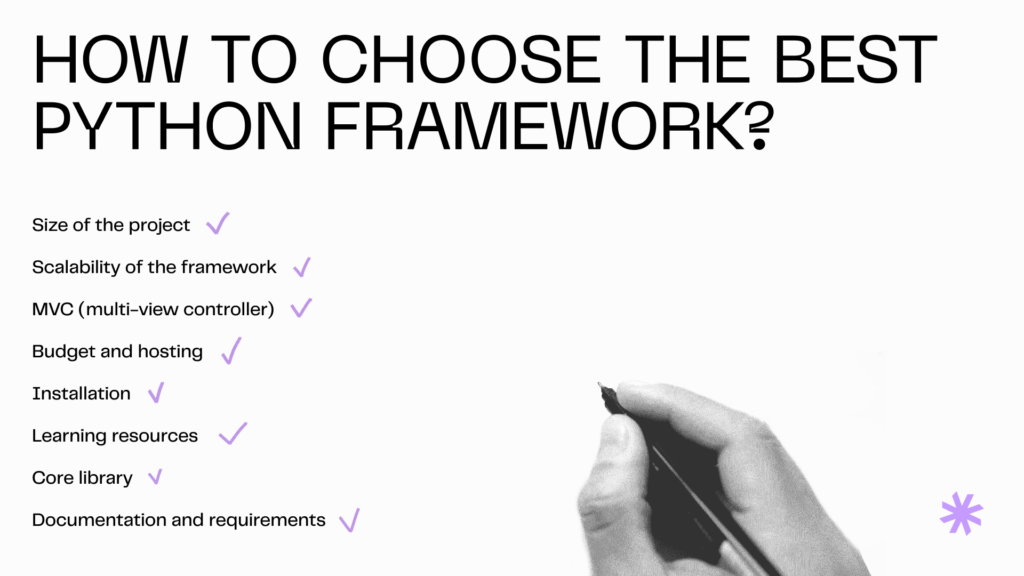
Need help with software development?
Our Python specialists will guide you in selecting the ideal tech stack and creating a tailored development plan based on your project requirements and resources. Start the conversation by sharing some details about your project.
Send messagePython microframeworks
Microframeworks are lightweight web frameworks designed for simplicity and minimalism. Unlike full-stack frameworks, microframeworks provide only the essential components needed for software development with Python, leaving the developer to choose the additional tools and libraries. They are well-suited for small to medium-sized projects where a full-stack framework might be overkill.
- Flask
This web framework for Python follows a minimalistic approach, allowing developers to choose and integrate components as needed. Its key characteristics include:
- Versatility: Flask is designed to be flexible, allowing developers to choose and integrate the components they need. It doesn’t impose a specific structure on your project, giving you the freedom to organize it as you see fit.
- Extensibility: Flask comes with a minimalistic core, and you can add extensions or plugins based on your project’s requirements. This modularity allows you to keep your application lightweight while still having the option to extend its functionality.
- Bottle
This microframework of Python is designed to be easy to use and has a small footprint. Its key features are:
- All-in-one approach: Bottle takes a minimalist approach by providing everything you need in a single file. This simplicity is great for small projects or when you want a quick and easy setup without dealing with a lot of configurations.
- Single codebase: With Bottle, you often end up with a single Python file for your entire application, making it easy to manage and suitable for small to medium-sized projects.
- Falcon
Falcon is designed specifically for building fast and RESTful APIs. Its key features include:
- API-focused design: Falcon prioritizes simplicity and speed, allowing developers to focus on creating robust APIs with minimal overhead.
- Efficient request handling: This lightweight and fast framework makes it an ideal choice for scenarios where response time is critical.
Read also: How to choose the right tech stack for your project?
Asynchronous Python frameworks
Asynchronous frameworks allow developers to write code that efficiently handles concurrent tasks without blocking the execution flow. These frameworks are particularly well-suited for software development with Python, where high concurrency, responsiveness, and the ability to handle many simultaneous connections are required.
Below is a brief comparison between the top popular asynchronous frameworks for Python software development.
| FastAPI | Tornado | Sanic | |
|---|---|---|---|
| Design philosophy | Runtime efficiency | Scalability | Modularity |
| Popular use cases | API development | Handling simultaneous connections | Handling a high volume of concurrent requests |
| Data validation and documentation | Type hints and Swagger UI/ ReDoc integration | Type hints and Swagger UI/ ReDoc integration | Type hints and Swagger UI integration |
| WebSocket support | Yes | Yes | Yes |
| Dependency injection | Built-in | No built-in mechanism | Relies on extensions |
| Security features | Can be added | Can be added | Built-in |
Famous examples of Python applications
Python’s simplicity and extensive library and framework ecosystem make it a versatile choice for a range of projects. It’s commonly used for developing dynamic web applications, creating automation scripts to streamline repetitive tasks, and handling tasks like simulations, data analysis, and control systems.
The language has become a go-to choice for data science and machine learning, positioning itself as a leading language in the realms of artificial intelligence (AI) and machine learning (ML), including applications in Natural Language Processing (NLP). Surprisingly, Python is also applicable in game development.
Let’s explore some of the well-known applications of Python in software that everyone either uses or is at least familiar with.
The famous media-sharing platform relies on Python to handle the vast amount of data flowing through its backend infrastructure. Python’s scalability contributes to the smooth functioning of the platform.
YouTube
YouTube uses Python for managing video content and backend processes. Python’s versatility and extensive library are crucial in handling user traffic, ensuring a seamless experience for both viewers and creators.
Dropbox
Dropbox employs Python for both its server and desktop applications. The cross-platform support, readability, and ease of learning of Python have been instrumental in Dropbox’s early and rapid scaling.
Spotify
Spotify’s backend is powered by Python, aiding in data processing and analytics. Python’s ease of use and advanced data analytics contribute to Spotify’s ability to deliver a personalized and smooth music streaming experience.
Reddit leverages software development with Python for various functionalities. The platform benefits from Python’s conciseness, leading to faster loading times and making the code easy to read and maintain.
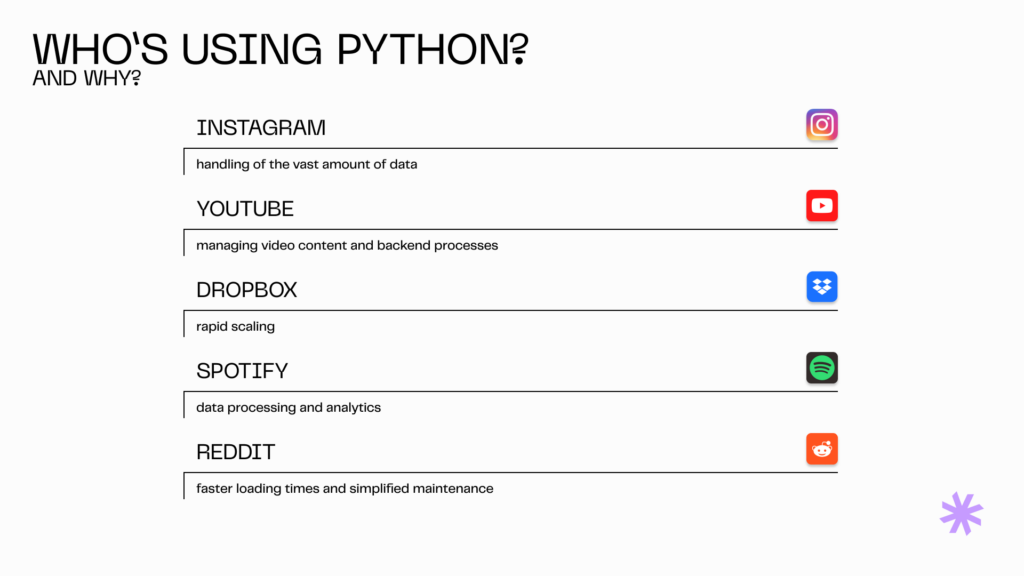
Got a groundbreaking app idea?
Syndicode has the expertise to turn your idea into reality and boost your chances of success. Request a consultation to see what we can do for you.
Message usWhen not to choose Python for software development?
While being a versatile and widely used programming language, software engineering with Python has its limitations. Here are the main disadvantages of Python, along with scenarios where choosing another technology might be more suitable:
Performance-critical applications
Python is an interpreted language, which can result in slow execution. For applications where high performance is critical, such as intense numerical computations or system-level programming, languages like C or C++ might be more suitable.
Mobile development
Python is less prevalent in mobile app development than languages like Swift (for iOS) or Kotlin/Java (for Android). For native mobile app development, choosing platform-specific languages is often preferred for better integration with the respective mobile ecosystems.
Real-time systems
Python’s garbage collection and dynamic typing may introduce unpredictable delays, making it less suitable for real-time systems where precise timing is crucial. For applications with strict real-time requirements, languages like C or Ada, designed for deterministic behavior, are better choices.
Highly-concurrent systems
Python’s Global Interpreter Lock (GIL) can limit the concurrency of multi-threaded applications, impacting performance. For highly concurrent systems, languages with better support for parallelism, such as Go or Erlang, may be more appropriate.
Interfacing with legacy code
While software development with Python offers ways to interface with legacy code, it might not be as seamless as using languages like C or Java for specific legacy systems. For projects heavily dependent on interfacing with existing legacy codebases, choosing a language compatible with those systems may be more practical.
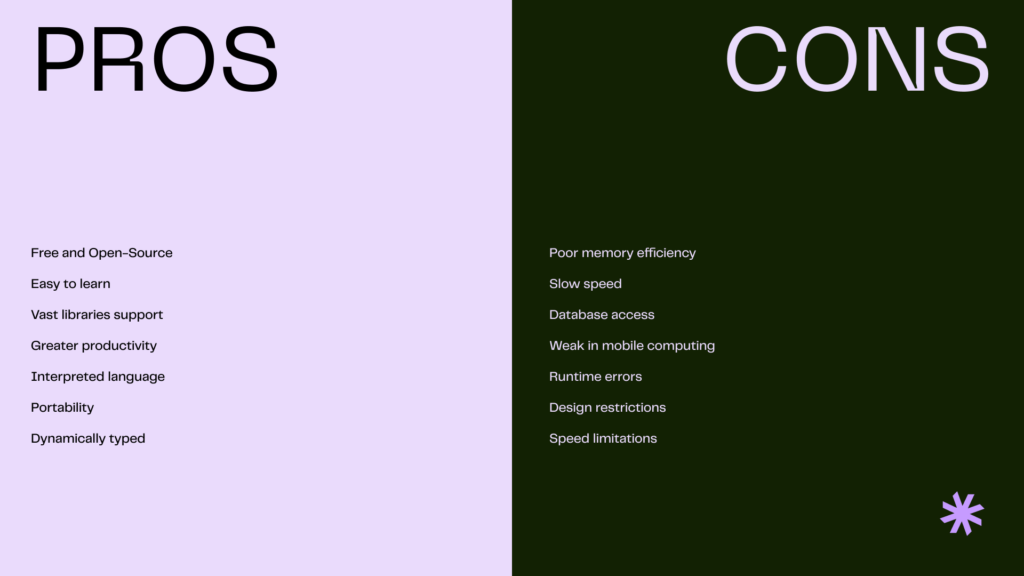
Summary
Python is an excellent programming language for both developers and businesses. It’s relatively easy to learn because of its straightforward and clear syntax. Plus, it boasts a lively community that offers a plethora of resources, tutorials, and libraries for almost any situation.
From a business standpoint, opting for Python in software development ensures that you can always find a developer, whether hiring locally or outsourcing.
If outsourcing is your choice, Syndicode can provide experienced Python developers and other specialists crucial for successful project development. Our team prioritizes a problem-solving mindset, strong communication skills, and a commitment to continuous learning. Our employees are well-versed in all popular Python frameworks and tools, adhering to best practices.
Feel free to drop us a message describing your project and needs, and we’ll get back to you with suggestions on how to build your software using Python or other tech.
Frequently asked questions
-
What software can I create with Python?
Python is a flexible programming language suitable for a range of software applications. It’s commonly used for developing websites, web applications, data analysis, and visualization. Python is also handy for creating automation scripts, artificial intelligence (AI), machine learning (ML) applications, educational tools, and even basic mobile apps and games. However, software development with Python is not without limitations. We recommend consulting with a trusted Python development company for guidance on the most suitable tech stack for your specific project. They can help tailor the approach to meet your project’s unique requirements.
-
Is Python good for mobile app development?
Python isn’t as commonly used for mobile app development as Java or Swift, but it can still be utilized through specialized frameworks. One such framework is Kivy, which is designed to build multi-touch applications. Kivy supports both Android and iOS, enabling the creation of mobile apps with a natural touch interface. Another approach to integrating Python into mobile app development involves using tools like React Native for Python or SL4A (Scripting Layer for Android). However, it’s important to note that if your mobile application is resource-intensive or requires specific features tied to a particular platform, considering other languages might be advisable.
-
What are the disadvantages of Python language?
Python, being an interpreted language, has several disadvantages. One notable drawback is its slower performance compared to compiled languages like C++ or Java. This can be a concern for performance-critical applications or tasks. Additionally, Python software development is not suitable for low-level system programming where precise control over hardware is essential. Another limitation stems from Python’s use of a Global Interpreter Lock (GIL), which restricts the effectiveness of multi-core processors for CPU-bound and multithreaded applications. While there are frameworks like Kivy and BeeWare for mobile development with Python, the ecosystem is not as dominant as native languages like Swift for iOS or Java/Kotlin for Android. This can limit options and performance for certain mobile applications. Moreover, Python application development tends to produce larger file sizes, which may pose issues.
-
What are the best frameworks for Python?
Python is recognized for its diverse frameworks that cater to various development needs. The most popular ones are Django and Flask, which are widely utilized for full-stack Python software engineering. Additionally, NumPy and Pandas are ideal for high-performance tasks like scientific projects. If you’re interested in creating desktop applications with sophisticated graphical interfaces, Python offers GUI frameworks like Tkinter and PyQt with PySide. Another noteworthy framework is FastAPI, which is widely used for constructing APIs and microservices architectures.
-
How to hire a good Python developer?
To find a good Python developer, start by clarifying your project requirements through discussions with your team and stakeholders. Define the necessary skills, experience level, and familiarity with specific frameworks or tools. Then, craft a detailed job description that clearly outlines the expectations and opportunities associated with the role. Now it’s time to announce the open position on relevant platforms like job boards, LinkedIn, and tech job websites. You can also explore outsourcing companies, such as Syndicode, to find suitable talent. After you have received enough applications, review resumes to identify candidates with relevant education, experience in Python software development, and skills. Conduct a brief initial screening to assess basic technical knowledge, communication skills, and cultural fit. Further, administer technical assessments, like coding tests or take-home assignments, to evaluate candidates’ coding skills. For those who pass the assessments, conduct a behavioral interview to evaluate problem-solving abilities, teamwork, and communication skills. Consider reaching out to previous employers or colleagues listed in the candidate’s references. Finally, identify a strong candidate and discuss salary, benefits, and other terms. Remember the importance of onboarding. Develop a comprehensive plan to help the new Python app developer integrate smoothly into the team, providing access to necessary tools, documentation, and resources to enhance productivity.
-
How much do Python developers charge?
The rates that Python developers charge can vary widely for various reasons. Factors like their experience level, location, project complexity, and specific skills needed all play a role. Thus, the hourly rate for entry-level freelance specialists in Eastern Europe is usually around $10-20. Meanwhile, their counterparts in Western Europe typically charge between $30-50 per hour. In the U.S., junior Python developers usually ask for $50-70 per hour. Development agencies tend to have higher rates, ranging from $50 to $200 per hour. At the same time, they offer advantages like handling overhead issues, providing greater security compared to individual freelancers, and offering management assistance. Developers with expertise in specific industries (like finance, healthcare, or artificial intelligence) may charge higher rates due to their specialized knowledge. It’s important to note that rates are often negotiable. Python app developers may provide discounts for long-term commitments or larger projects. When choosing a development partner, focus on their reliability and understanding of your project rather than just the cost.
